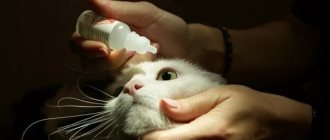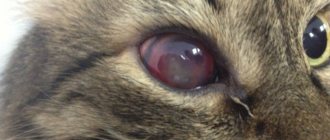Owners of domestic cats sometimes notice the appearance of discharge from the vaginal area, which is a liquid substance. The nature of the discharge may be serous or watery, and may also contain blood or pus (yellowish or green discharge). After the end of the birth process, vaginal discharge is dark, sometimes black or greenish.
The appearance of discharge from the vaginal area does not always indicate the development of a pathological process in the female reproductive system. Some types of discharge are physiologically determined and do not pose a threat to the life of the animal.
The presence of discharge in an animal should not be ignored, since in some cases such a symptom indicates the development of pathological changes in the area of not only the genital tract, but also the urinary system. It is recommended to contact a veterinary clinic to determine the nature of the origin of the cat’s discharge. The doctor will be able to make an accurate diagnosis and prescribe appropriate treatment.
Causes
All vaginal discharge is divided into natural and pathological.
They vary in color and consistency, and during estrus can be clear, white or red. However, there are situations where a cat owner may confuse estrus with vaginal discharge occurring for another reason. There are the following characteristic causes that occur during estrus, or are mistaken by the cat owner for estrus:
- Vaginitis.
- Endometritis.
- Hydrometer.
- Hematometra.
- Pyometra.
- Tumor formation.
With vaginitis (inflammation of the vagina), a characteristic symptom is frequent licking. At first, the discharge is difficult to notice, since the cat hides it itself. As the process develops, watery excreta appears, transforming into whitish, mucous excreta. If vaginal discharge continues for a week or more, seek veterinary attention.
Frequent licking of the genitals is an alarming symptom
Endometritis is an inflammation of the uterus that can be chronic or acute. During the manifest process, estrus does not occur. The discharge can be of any color, smell and consistency. Without treatment, the animal dies.
Chronic inflammation of the uterus does not pose a threat to life. Most often, the discharge is white, scanty, and smeared. Estrus proceeds as usual, but conception does not occur. Sometimes a cat manages to become pregnant, but the kittens die in the womb or are born weakened.
Chronic endometritis can transform into hydrometra when fluid accumulates in the uterus. It is secreted in drops or mucous excretion and is colorless or whitish.
Hematometra is an accumulation of blood in the uterus. Develops as a result of hemorrhage of traumatic, inflammatory origin or a clotting disorder. It is characterized by bloody excretion, released in drops or clots.
Pyometra is purulent inflammation of the uterus. The discharge may be white, reddish or brown. Lack of treatment ends in death.
Tumor processes are accompanied by tissue destruction and can have a variety of colors and textures.
Endoscope for small animals
Purulent, bloody, or yellow discharge
Bloody, purulent or yellow vaginal discharge in a cat almost always indicates the development of inflammation. Bloody discharge in a cat during the postpartum period is considered normal and is called lochia. They can be pinkish, dark brown or almost black. The duration of lochia is from 2 to 3 weeks. Normally, discharge after childbirth should not have an unpleasant odor.
It is important to note that during the onset of the heat period, cats, unlike dogs, do not experience bleeding. Therefore, if an animal intensively licks the vulva area, and droplets of blood are visible on the bedding, it is necessary to contact a veterinary hospital for advice as soon as possible.
Yellow or white discharge is normal before labor begins. A day or several hours before birth, the owner may notice the appearance of clear, whitish or greenish discharge from the loop. Discharge that does not go away for a long time and has an unpleasant odor is a signal of the development of pathology. You cannot do without the help of a veterinarian. When examined by a specialist, the female is not only given a clinical examination, but also prescribed a number of laboratory tests. An obligatory point in making a diagnosis is ultrasound diagnostics.
Among the pathological causes that provoke the appearance of specific exudate from the vagina in a cat are the following:
- Pyometra is a dangerous pathology caused by purulent-necrotic inflammation in the uterine cavity. In the open form of pyometra, exudate is released, initially cream-colored, then green, yellow, bloody with impurities of pus. In some cases, conservative treatment is carried out, which is effective in the initial stages of the disease. In case of advanced pathological process, it is recommended to perform extirpation of the uterus and appendages.
- Hematometra is a disease characterized by the accumulation of a large amount of blood in the uterus against the background of hemorrhage, provoked by an advanced form of endometritis or mechanical damage. Symptoms of hematometra in a cat are bloody discharge from the loop, liquid or in the form of clots, and have an unpleasant odor. Pathogenic microflora often joins, which leads to the appearance of pus.
- Hydrometra is a pathological process that occurs against the background of other diseases, for example, endometritis that is not treated in a timely manner. It is characterized by an increased accumulation of serous exudate in the uterine cavity.
- Endometritis is a commonly diagnosed disease in unsterilized cats. Pathology occurs as a result of the development of inflammation on the inside of the uterine layer. The disease can occur in both acute and chronic forms. The discharge in the initial stages of endometritis is cloudy, yellowish, and has a repulsive odor. Endometritis does not pose a direct threat to the life of a cat, but it is fraught with the development of complications in the absence of therapy.
Before contacting a veterinary clinic, the owner should carefully examine the type of discharge, its intensity, smell and color. This will help the doctor collect a medical history to make an accurate diagnosis. A number of important studies are carried out in the clinic, including:
- general clinical blood test;
- blood biochemistry;
- bacterial culture of vaginal exudate samples to determine the sensitivity of microflora to antibiotics;
- scraping for cytological examination;
- ultrasound diagnostics of the abdominal organs.
In some cases, it is recommended to conduct serological tests for herpes and brucellosis, and study the functioning of the renal system (to determine possible concomitant pathologies).
If the discharge that appears from the vaginal area in a female is physiologically caused, therapy is not carried out. In clinical veterinary practice, there have been cases of vaginitis occurring in young cats. After going through the first heat or undergoing a sterilization procedure, vaginitis disappears on its own.
Pathological vaginal discharge requires concentration from a specialist to make a diagnosis and prescribe treatment. Depending on the type of pathology and the degree of neglect, treatment will vary.
If a cat has an infection of the reproductive system with damage to the walls of the uterus, a foreign body is found in the birth canal, or malignant tumors are diagnosed, surgical treatment is prescribed. Surgical treatment is also carried out when diagnosing congenital anomalies in the structure of the ureter and the walls that form the vaginal opening.
Purulent discharge caused by the attachment and development of pathogenic bacterial microflora is stopped with the help of antimicrobial agents. A course of antibiotic therapy is prescribed, the dosage and treatment regimen of which is determined by the veterinarian.
If disorders in the blood clotting system are diagnosed, corrective treatment is carried out. In some cases, when the cause of a cat’s discharge from the loop is a tumor, not only surgery is performed, but chemotherapy is also prescribed.
Treatment
Therapeutic measures are prescribed if it is determined that vaginal discharge is pathological. Depending on the diagnosis, the following medical techniques are used:
- Hemostatic therapy if a blood clotting disorder is established.
- Inhibition of the activity of pathogenic microflora. Antibiotic therapy.
- Extirpation of the uterus.
- Removal of tumors.
The use of steroidal antiphlogistic drugs is contraindicated. An attempt at self-medication poses a mortal threat to the pet, causing immediate death or provoking the formation of malignant tumors.
We invite you to join our Zen channel and group on VKontakte or Odnoklassniki, where new articles for pet owners are published.
Similar articles:
- My cat has a nosebleed - what should I do?
- Inflammation of the lower lip in a cat
- Clear nasal discharge in cats
Discharge in diseases
Discharge in cats is considered pathological in some diseases, such as inflammatory diseases of the urinary system, infectious diseases of the bladder, urinary tract, genitals, and uterus. These diseases can cause serious complications and irreversible consequences for your pet's health. Such discharge usually has a thick consistency, odorless, and is opaque, pink or reddish in color.
For vaginitis
the inflammatory process is localized on the walls of the cat’s vagina and is accompanied by mucous or cloudy discharge. They bother the cat, and the pet often licks itself. In this situation, you should show the cat to the veterinarian in a timely manner to avoid the development of complications, ascending urinary tract infections, cystitis and pyometra.
In case of trauma to the vagina and uterus, the discharge is profuse, bloody or pink. When infected, purulent discharge appears.
Endometritis
– inflammatory disease of the internal mucous membrane of the uterus.
Separately, there is an acute form of endometritis, which occurs a few days after childbirth. This complication is associated with retained placenta and infection. Pyometra
. This is a purulent inflammatory disease of the uterus that is dangerous to the health and life of a cat. It is more common in young individuals under three years of age, nulliparous and unsterilized. Pyometra can occur as a complication from the use of hormonal drugs that reduce sexual activity.
There is an open form of pyometra, in which copious discharge flows out when the cat stands or lies, and a closed form. The closed form of pyometra is the most dangerous, since when the cervix is blocked, pus, blood and mucus accumulate in the cavity. This leads to the development of intoxication, uterine rupture, peritonitis and death of the cat.
If pathological discharge is observed in a sterilized cat, it indicates the same inflammatory diseases, for example, vaginitis. Another reason may be inflammation or the development of a tumor after incomplete removal of the ovary. Inflammatory, infectious and tumor processes can also develop in the uterus of a sterilized cat.
Negative reasons for discharge
The causes of intrauterine bleeding in cats can be different.:
- Inflammatory diseases, including endometritis, pyometra. The reproductive system of a pet includes the ovaries, uterus, vagina and external genitalia. They are manifested by the animal’s restlessness, the appearance of aggressiveness, and active licking of the external genitalia;
- Damage to the uterus. Accompanied by copious bleeding. There are many blood vessels on the walls of this organ;
- Oncological diseases of cats. Cancer cells suppress the general immune system, including the genitourinary system. Danger is indicated by purulent bloody discharge with an unpleasant odor. They are caused by the growth or destruction of a tumor;
- Decaying placenta. It is possible that after birth, part of the placenta will remain inside. This leads to its decomposition. As a result, blood comes from the vagina. There is a high probability of surgical intervention.
© shutterstock
Disease Prevention
To keep your animal from getting sick, you need to properly maintain and care for it. preventive measures will help avoid many diseases or serious consequences after childbirth.
It is not recommended to abuse hormonal drugs to control the reproductive cycles of an animal. It must be remembered that frequent use can negatively affect the animal’s well-being and cause irreversible processes in the reproductive system. It is prohibited to exceed the dosage of hormonal drugs and the duration of the course.
During delivery, it is necessary to follow the rules of antiseptics. The birth should take place in a clean place where the cat can feel calm.
Mating should only be done with a healthy cat that does not have genitourinary infections. This circumstance can be confirmed by a certificate from a veterinary clinic. It is strictly forbidden to let a cat go outside during heat. Since in one hundred percent of cases this will end in pregnancy from an unknown cat, which may be contagious.
A sterilized animal must be shown to a veterinarian once every six months for an ultrasound of the reproductive system. This must be done, since sterilized cats often develop neoplasms.
If there is any suspicious pinkish or red discharge, the animal should be shown to a doctor. This will help to recognize the disease in time and begin treatment.
This article has been checked and approved by a veterinarian. Knyazeva Anna Vladimirovna, veterinarian in private practice, Moscow. more about the expert.
(you can vote for the article)
Tags: cat discharge, cat health, cats
- Related Posts
- TOP 13 vitamins for cats that boost immunity
- The cat is in her first heat: what to do?
- What to feed a British kitten?
Normal discharge in a cat before giving birth
A few days before the onset of contractions (usually from 63 to 65 days of pregnancy), the body begins to prepare for childbirth. Normally, the mucus plug comes off about a day before the onset of contractions. However, as the experience of owners shows, the mucous plug can come off several weeks before birth.
Note! The mucus plug may be streaked with blood as the blood supply allows it to renew and enlarge as the kittens grow.
In any case, if you notice that there is pink discharge left on your cat’s fur, most likely these are traces of a mucus plug. The pigmentation of the mucus plug can vary from clear to creamy to greenish in color. The volume of mucus released is an individual indicator. Most owners do not monitor the process of the mucus plug coming out, since it is very small and remains in the litter tray after urination.
Does my dog have a genital disorder?
The following symptoms may indicate an infection or disease:
- Vulvar discharge containing pus or blood.
- Licking the vulva.
- The dog rubs its butt on the ground.
- Frequent urination.
- Discomfort associated with urination.
- Sexual interest of the opposite sex in a female is not in heat.
- Vomiting and lack of appetite.
Since there are so many causes for this condition, it is highly recommended that you consult your veterinarian.
Call a veterinarian Moscow
+7(495)162-70-70
Symptoms of uterine bleeding
What symptoms indicate bleeding? With hidden bleeding, the cat becomes lethargic, inactive, and has an impaired appetite. Severe shortness of breath and increased fatigue appear. The temperature on the skin of the paws is significantly lower than the body. The abdomen is dense, enlarged, the mucous membranes are pale. Symptoms increase gradually over a period of several days to several weeks.
The owner should not forget that during intrauterine bleeding, almost all the blood remains in the organ cavity. And only in isolated cases are spots on the external genitalia. Such bleeding is very dangerous because it is detected too late.
If there is obvious bleeding, the cat coughs up blood, vomits, and the stool becomes liquid with bloody streaks. Bloody discharge from the loop and blood in the urine are observed. It is important to immediately consult a doctor if the symptoms listed above are present, as well as if the bleeding continues for more than 15 minutes and the cat has significant blood loss after it stops.
© shutterstock
First aid when a cat is bleeding from the vagina prohibits any independent actions.











